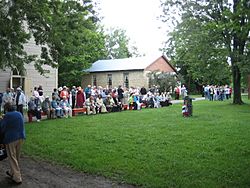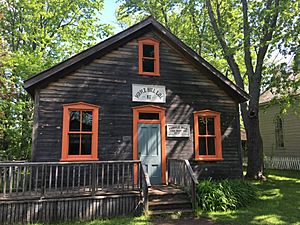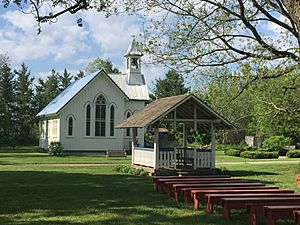Fanshawe Pioneer Village facts for kids
 |
|
| Lua error in Module:Location_map at line 420: attempt to index field 'wikibase' (a nil value). | |
| Established | 1959 |
|---|---|
| Location | 2609 Fanshawe Park Road East London, Ontario, Canada N5X 4A1 |
| Type | historic site |
| Collection size | 33 buildings |
| Owner | London and Middlesex Heritage Museum |
| Public transit access | none |
| Nearest car park | on-site, free |
Fanshawe Pioneer Village is a special outdoor museum in London, Ontario. It was started in 1959. This village helps people learn about what life was like in rural communities in Middlesex County from 1820 to 1920. It also shows how the City of London began and grew until 1840. The village uses actors and real historical buildings to show how people lived long ago.
The London and Middlesex Heritage Museum, a non-profit group, runs Fanshawe Pioneer Village. They work with the City of London and other local groups. Their main goal is to help everyone connect with history and old traditions through fun, hands-on experiences.
Contents
Discovering the Past: How Fanshawe Pioneer Village Began
Fanshawe Pioneer Village was first thought of in 1955. The Upper Thames River Conservation Authority wanted to protect old buildings in the Thames River area. The Village officially opened on June 26, 1959. Dr. Wilfrid Jury, who was a director at the University of Western Ontario's museum, helped a lot.
In 1961, the village area grew to 2.2 acres. By 1963, another 22 acres were set aside for future growth. Dr. Jury had collected many old pioneer items. These items were brought to the Village and officially given to the Conservation Authority in 1978. By 1980, the Village had 23 buildings. Today, it has 33 original and copied historic buildings spread across 46 acres.
Exploring the Museum and Its Programs
Fanshawe Pioneer Village has a large collection of items important to the history of London and Middlesex County.
What You Can See: The Village Collection
The collection includes over 25,000 items. These items show what life was like long ago. You can see old furniture, art, clothes, and fabrics. There are also old documents, household tools, vehicles, and farm equipment. All these items were given by people living in London and Middlesex County.
Learning Through Fun: Educational Events
Fanshawe Pioneer Village hosts many history-based events each year. These events help the community get involved and learn about the past in an exciting way.
Journey Through Time: The Village Buildings
Fanshawe Pioneer Village has 33 historic buildings. These buildings show how communities changed over one hundred years. The Village is divided into four main areas. Each area shows a different time period in the community's history.
Fanshawe Settlement: Life from 1820-1850
This area shows how early settlers from Europe and other parts of North America arrived in the London area. It also shows how they changed the land and affected the Aboriginal people living there.
- Log School – This is a copied building. It looks like the first log schools built by the Talbot settlers around the 1830s.
- Elgie Log House - This house shows what the first homes of the Talbot settlers in London Township looked like around 1820.
- Colbert Log Barn - This barn was built in the 1840s using strong rock elm logs. You could drive through it.
Fanshawe Corners: Growing Communities from 1850-1880
This part of the village shows the first steps of towns growing at important travel spots.
- African Methodist Episcopal Church- This was London's first church led by Black people. It was a community center and a safe place for the growing Black community.
- Blacksmith Shop- People like blacksmiths often set up their businesses at crossroads. This allowed them to serve many travelers and farmers.
- Corbett Tavern - This tavern from the 1840s offered places to stay, food, and stables for horses. It was also a meeting place for the community.
- Lochaber Church - This Free Presbyterian Church was built in 1884.
- Mount Moriah Lodge - Groups like the Masons first met in local taverns. Later, they built special halls like this one. The inside looks like an early 19th-century London Masonic Hall.
- Purple Hill Lodge - This building was created by Protestant Irish immigrants who brought their traditions, called Orangeism, to Canada. Many towns in southwestern Ontario built meeting halls for the Orange Order. These buildings were also important community centers for dances, dinners, and concerts.
Fanshawe Township: Farming Life from 1880-1910
This section tells the story of farming. Farming became the main way London and Middlesex County grew and developed.
- The Caverhill Farmstead - This farm shows what an established farm looked like after a family had lived there for several decades.
- Fanshawe School - Schools for children became more organized by the government. They had set lessons and children had to attend. This one-room schoolhouse from 1871 is a good example of many schools in Middlesex County.
- Jury Farmstead - This was the childhood home of Wilfrid Jury, who started Fanshawe Pioneer Village. It shows what a farm looked like for a second-generation family around 1900.
The Town of Fanshawe: Changes from 1910-1920
This area shows the fast changes that happened in the early 20th century.
- Alder's Weaving Shed- This is Thomas Alder's original weaving shed from the 1850s.
- Denfield General Store - Here, customers could buy or order almost anything they needed. They could also get credit or send messages through the telegraph, telephone, or mail.
- Peel House- This was the childhood home of London artist Paul Peel. It shows what a city home looked like around the early 1900s.
- Harmer Sawmill- Sawmills cut wood for building. Wooden frame houses quickly became more common than log houses because local sawmills made wood easy to get.
- Dr. Jones House and Barn– This home is on the edge of the town. The barns are still used, but the farmland is rented out. This shows that the owner, a rural doctor, had another job besides farming.
- The Print Shop- This print shop looks like one from the early 1900s. It printed newspapers like the London Free Press and other materials.
- Trinity Anglican Church- This Anglican church was built in 1887. It is a great example of a "carpenter Gothic" church, known for its wooden details that look like stone Gothic architecture.
See also





